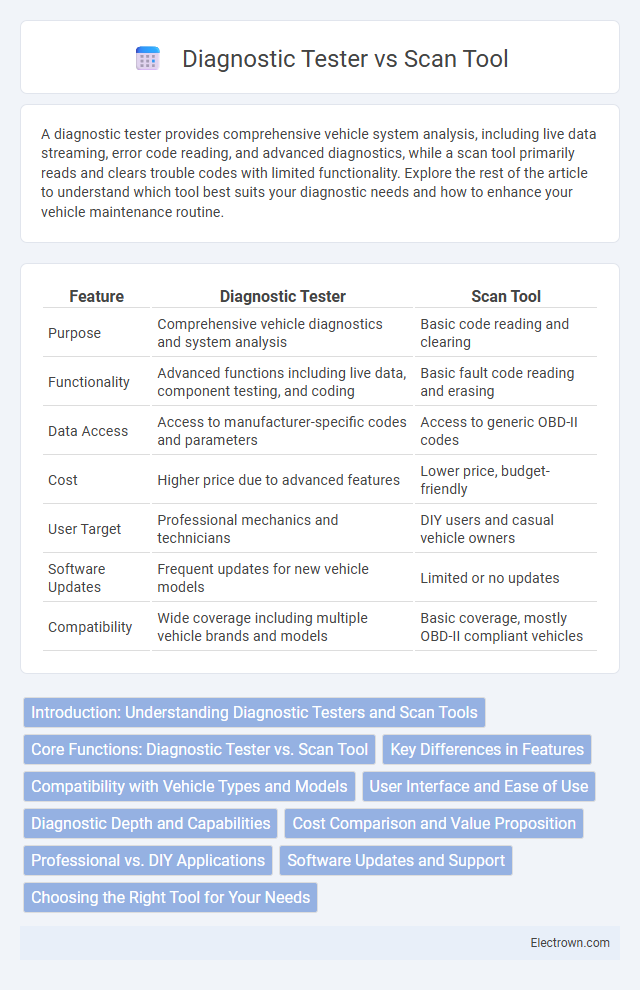A diagnostic tester provides comprehensive vehicle system analysis, including live data streaming, error code reading, and advanced diagnostics, while a scan tool primarily reads and clears trouble codes with limited functionality. Explore the rest of the article to understand which tool best suits your diagnostic needs and how to enhance your vehicle maintenance routine.
Table of Comparison
| Feature | Diagnostic Tester | Scan Tool |
|---|---|---|
| Purpose | Comprehensive vehicle diagnostics and system analysis | Basic code reading and clearing |
| Functionality | Advanced functions including live data, component testing, and coding | Basic fault code reading and erasing |
| Data Access | Access to manufacturer-specific codes and parameters | Access to generic OBD-II codes |
| Cost | Higher price due to advanced features | Lower price, budget-friendly |
| User Target | Professional mechanics and technicians | DIY users and casual vehicle owners |
| Software Updates | Frequent updates for new vehicle models | Limited or no updates |
| Compatibility | Wide coverage including multiple vehicle brands and models | Basic coverage, mostly OBD-II compliant vehicles |
Introduction: Understanding Diagnostic Testers and Scan Tools
Diagnostic testers and scan tools are essential devices used to identify and troubleshoot vehicle issues by reading error codes from the onboard computer system. Diagnostic testers offer advanced functions such as live data streaming, bi-directional control, and module programming, enabling mechanics to perform in-depth analysis and repairs. Scan tools provide a more basic, user-friendly interface for retrieving and clearing diagnostic trouble codes, making them suitable for quick diagnostics and routine maintenance.
Core Functions: Diagnostic Tester vs. Scan Tool
Diagnostic testers provide comprehensive vehicle analysis by accessing and interpreting detailed error codes, sensor readings, and live data streams essential for pinpointing complex mechanical and electronic issues. Scan tools primarily read and clear diagnostic trouble codes (DTCs) from the vehicle's onboard computer, offering basic functionality for quick codes retrieval and reset. The diagnostic tester supports advanced troubleshooting by enabling bi-directional control and system-specific tests, whereas scan tools are generally limited to standard code reading and clearing functions.
Key Differences in Features
Diagnostic testers provide comprehensive vehicle diagnostics with advanced functions such as live data streaming, bi-directional controls, and coding capabilities, enabling in-depth analysis and repair. Scan tools primarily offer basic OBD-II code reading and clearing, making them suitable for quick fault detection and simple maintenance tasks. The enhanced features of diagnostic testers support professional mechanics in detailed troubleshooting, whereas scan tools cater to general users seeking rapid diagnostics.
Compatibility with Vehicle Types and Models
Diagnostic testers offer broad compatibility across various vehicle makes and models, providing in-depth system analysis for professional mechanics. Scan tools generally support multiple vehicle types but may have limited functionality on newer or less common models compared to advanced diagnostic testers. Compatibility depends on the software updates and protocols supported by the device, with diagnostic testers typically receiving more frequent updates for a wider range of vehicles.
User Interface and Ease of Use
Diagnostic testers feature advanced user interfaces with touchscreens, intuitive menus, and often include guided troubleshooting, making them ideal for professional mechanics requiring in-depth analysis. Scan tools typically offer simpler interfaces with basic navigation and limited interactive features, suited for DIY users or quick vehicle checks. The ease of use in diagnostic testers is enhanced by software updates and detailed graphical displays, whereas scan tools prioritize straightforward operation and accessibility.
Diagnostic Depth and Capabilities
Diagnostic testers offer advanced diagnostic depth with capabilities including comprehensive vehicle system analysis, live data streaming, and bidirectional control, enabling precise troubleshooting and detailed fault code interpretation. Scan tools primarily provide basic fault code reading and clearing functions with limited system access, suitable for general diagnostics and routine maintenance. Professional diagnostic testers support manufacturer-specific protocols and updates, enhancing functionality beyond the generic scan tool's scope.
Cost Comparison and Value Proposition
Diagnostic testers typically cost significantly more than basic scan tools, often ranging from hundreds to thousands of dollars, reflecting their advanced capabilities in vehicle diagnostics. While scan tools provide essential codes and limited data for general vehicle troubleshooting at a lower price, diagnostic testers deliver comprehensive analysis, live data streams, and bi-directional controls, offering greater value for professional mechanics. The higher initial investment in diagnostic testers is justified by enhanced accuracy and efficiency in diagnosing complex automotive issues, leading to long-term savings on repair time and costs.
Professional vs. DIY Applications
Diagnostic testers provide advanced, comprehensive vehicle diagnostics tailored for professional mechanics and automotive technicians, offering extensive system coverage and detailed fault analysis. Scan tools are typically designed for DIY enthusiasts, delivering basic error code reading and clearing functions suitable for routine maintenance and simple troubleshooting. Your choice depends on whether you need in-depth diagnostics for professional repair or straightforward tools for home vehicle care.
Software Updates and Support
Diagnostic testers offer comprehensive software updates and ongoing support directly from vehicle manufacturers, ensuring compatibility with the latest models and enhanced diagnostic features. Scan tools typically provide limited software updates and may rely on third-party support, which can restrict access to proprietary vehicle codes and advanced system diagnostics. Regular software updates for diagnostic testers improve accuracy and functionality, while scan tools focus more on basic diagnostics with less frequent or user-initiated updates.
Choosing the Right Tool for Your Needs
Diagnostic testers offer comprehensive vehicle analysis with advanced features like live data streaming and bi-directional control, making them ideal for professional mechanics. Scan tools provide basic trouble code reading and clearing, suited for DIY enthusiasts seeking quick diagnostics without extensive technical detail. Evaluate your skill level and specific diagnostic requirements to choose the right tool that maximizes value and efficiency for your automotive maintenance.
Diagnostic tester vs Scan tool Infographic

 electrown.com
electrown.com